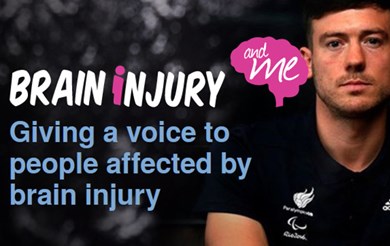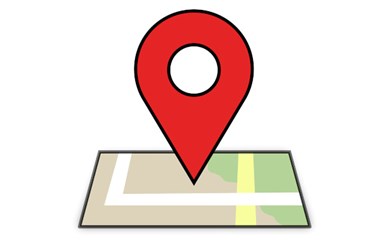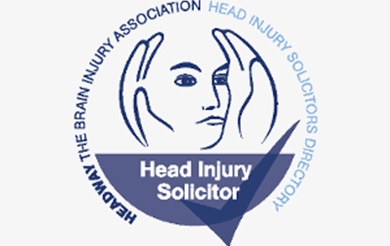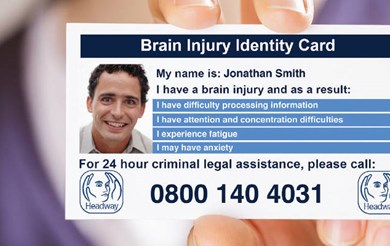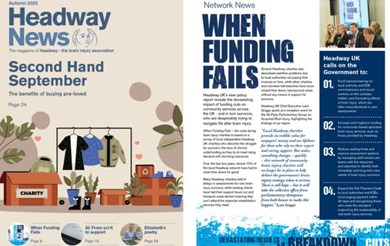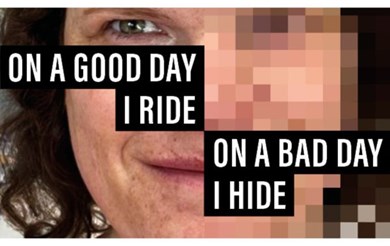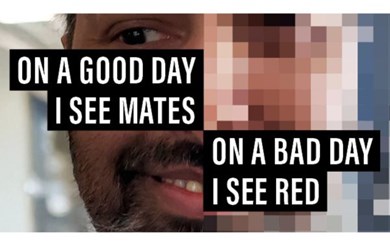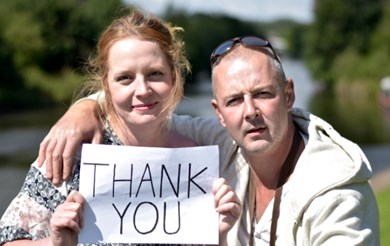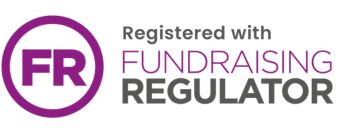Rehabilitation after brain injury
Rehabilitation after brain injury is largely unpredictable as every injury is unique. This section gives an overview of the processes and timescales for recovery and rehabilitation, explains how families can assist in the process, and details where people can receive help and support.
Unlike most other cells in the body, brain cells do not regenerate when they are destroyed. However, this does not mean that no recovery can occur. The brain is somewhat flexible and is able to reorganize itself, to an extent, in order to regain lost function. This is known as brain 'plasticity'.
During recovery, other areas of the brain take over the activities of the damaged areas and new nerve pathways can be established using undamaged brain cells. Engaging in activity helps these alternative pathways to develop.
Rehabilitation aims to help the brain learn alternative ways of working in order to minimise the long-term impact of the brain injury. Rehabilitation also helps the survivor and the family to cope successfully with any remaining disabilities.
Timescales for recovery and rehabilitation
In the first month or two after a severe brain injury it is only possible to guess at the length of time that recovery will take and the likely outcome. All that is certain is that recovery is a slow process and will take months or years rather than weeks.
Six months after the injury the picture will be clearer, but it is wise to wait until about a year after the accident before making any important decisions regarding the future. After a year or so one can be reasonably certain about the eventual degree of physical recovery. However, psychological recovery can take considerably longer and it is usually these more subtle psychological problems that cause longer-term difficulties, particularly for family members.
People do sometimes talk about there being a limited 'window' for recovery after brain injury, for example, that recovery ceases to take place beyond two years. However, this is now known not to be the case and people may actually continue to improve for a number of years after brain injury. Indeed, many people say that they never stop re-gaining the skills that they lost following the injury.
Nevertheless, the greatest visible progress does occur in the first six months or so post-injury and after this improvement is often less obvious.
Accessing brain injury rehabilitation services
There are many rehabilitation services across the UK, run by the NHS or private firms. You can search for Headway approved rehabilitation and care units in the Supporting you section or contact the Headway helpline for more information.
Choosing which rehabilitation unit to refer someone with a brain injury to should involve the clinical team, the patient and their family. Once a referral has been made, the rehabilitation unit will usually carry out an assessment to make sure their service is suitable.
Availability and funding for places varies. However, most units, including private ones, accept NHS referrals and will be funded by the NHS. Other possible sources of funding include the local authority, medical insurance, compensation claims and self-funding.
It is important to ensure that whoever is likely to have to fund the rehabilitation is aware that a referral has been made. The rehabilitation service will not be able to accept an admission until funding has been authorised. Many services accept referrals from outside their own area, but there are often limited places available and long waiting lists. Specific details about the referral process, availability of places and funding options will be available from the unit.
Taking up a rehabilitation placement is an important commitment, and it is wise to explore all the options, visit different rehabilitation settings, and ask as many questions as possible before a placement is confirmed.
Rehabilitation settings
Brain injury rehabilitation occurs in the following settings:
- Inpatient rehabilitation: This involves intensive specialist rehabilitation for people who are not yet ready to return home after discharge from hospital. Neurological rehabilitation centres provide an ideal setting for further treatment, where a structured rehabilitation programme is in place throughout the day.
- Outpatient rehabilitation: Some people may be well enough to return home and receive further treatment as an outpatient, either at a local hospital or at a separate rehabilitation centre.
- Community rehabilitation: Following an inpatient rehabilitation stay, some people may be transferred to a residential transitional living unit. Here people can develop their independent living skills so that they may be able to live in a place of their own. Others will go straight back to their homes, with a community rehabilitation team or outreach team helping them to make further progress; this may involve therapists working with the person in their home or community environment.
The role of family members in rehabilitation after brain injury
The British Society of Rehabilitation Medicine (BSRM) has produced guidelines on rehabilitation after acquired brain injury. The guidelines recognise the important role family members and carers play in the rehabilitation process:
"Family members are very often a crucial asset to the patient, providing both long-term support and a major contribution to the rehabilitation process. It is also important for the team to recognise that family members often have a special rapport with the patient and may detect subtle communication in advance of the professionals.
"Families can provide valuable insights into the patient's character, choices and ambitions, as well as important information on the presentation of difficulties in the home setting. This is essential in initial assessment, and in the monitoring of rehabilitation gain, to minimise under-reporting of difficulties when the brain-injured person lacks insight"
(From: Rehabilitation following acquired brain injury: national clinical guidelines, BSRM, 2003).
What if no rehabilitation has been provided?
If your relative has been discharged home without any access to rehabilitation, and you have reason to believe that they would benefit from it, there are still options available.
You are perfectly within your rights to actively seek rehabilitation services, even if you have been told that there are none available or needed. The first thing to do is discuss the matter with your relative's GP and/or consultant. They may be able to provide a referral. You can also contact rehabilitation services directly. The Headway helpline can provide information on specialist brain injury rehabilitation centres and you can search for Headway approved care providers in the In your area section.
It is advisable to contact several units and visit them to assess their suitability before making a decision. There are several other directories of rehabilitation professionals in private practice and you can find some of these in the Useful organisations section.
For more detailed information on brain injury rehabilitation see the Headway booklet Rehabilitation after brain injury, which you can download in the Related Resources section.
The rehabilitation team
Find out moreApproved care providers
Search our Headway Approved Provider directory for accredited brain injury residential care near you.
Find out moreIn your area
Find brain injury support in your area by searching our directory of local Headway groups and branches, specialist solicitors, approved care providers and charity shops.
Find out more